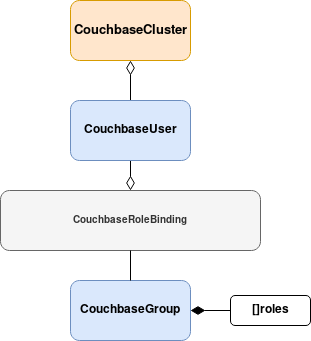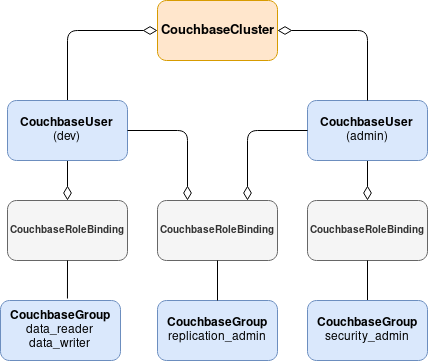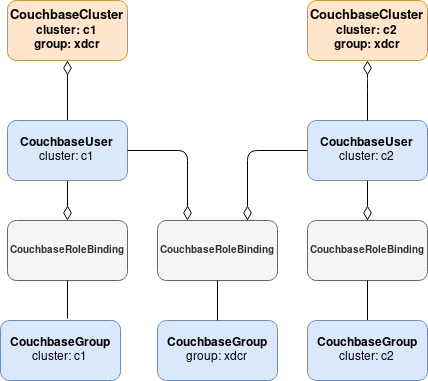Couchbase User RBAC
The Couchbase Autonomous Operator manages Couchbase Role-Based Access Control (RBAC) for the authorization of administrative users and groups.
Overview
Users are created when a CouchbaseUser resource is bound to one or more CouchbaseGroup resources using a CouchbaseRoleBinding resource.
The CouchbaseGroup resource contains a set of roles that are to be applied to one or more users.

The Autonomous Operator only creates users that are bound to groups. Therefore, all three resources are required in order to create an authorized user.
User Role Binding
A CouchbaseRoleBinding resource can bind multiple users to a single group.
This model is similar to Kubernetes RBAC which allows multiple service accounts to inherit roles from a single resource.
Separating user resources in this manner allows role definitions to easily be shared by multiple users.
Consider the following example that creates user accounts for a developer and security admin with overlapping roles.

In the diagram above, two users are created with the following privileges:
| Role | Privileges |
|---|---|
Application Developer |
|
Security Administrator |
|
Managing Groups
The CouchbaseGroup represents a collection of administrative and bucket roles which can be applied to users.
There is a direct association between the CouchbaseGroup resource and Couchbase Server RBAC groups such that Couchbase Server RBAC groups are created and deleted when corresponding CouchbaseGroup resources are created and deleted.
Whenever users are bound to a group, the Autonomous Operator ensures that the corresponding Couchbase Server RBAC group exists with the requested roles, and then proceeds to add the requested users to the group.
Setting Roles
Roles within a CouchbaseGroup resource can be added, removed, or changed.
Users only need to be bound once, and will automatically inherit any future changes to the roles in the group.
By default, bucket roles provide a user with access to all buckets. Buckets resources can be specified under the buckets property of each role, This will add a role for each bucket specified. The following example demonstrates how to restrict data writing to the default bucket, while allowing the user to read from any bucket.
apiVersion: couchbase.com/v2
kind: CouchbaseGroup
metadata:
name: datarole
spec:
roles:
- name: data_reader
- name: data_writer
buckets:
resources:
- name: default
kind: CouchbaseBucketIn versions Couchbase Server greater than 7.0.0, bucket roles can be specified for buckets, scopes and collections. In Couchbase Server versions before 7.0.0, these settings will be ignored. The following example demonstrates how to restrict data writing to the default bucket, scope and collection, while allowing the user to read from all scopes and collections within the default bucket.
apiVersion: couchbase.com/v2
kind: CouchbaseGroup
metadata:
name: datarole
spec:
roles:
- name: data_reader
buckets:
resources:
- name: default
kind: CouchbaseBucket
- name: data_writer
buckets:
resources:
- name: default
kind: CouchbaseBucket
scopes:
resources:
- name: default
kind: CouchbaseScope
collections:
resources:
- name: default
kind: CouchbaseCollectionMultiple Buckets, Scopes and Collections can be specified. However, CouchbaseScopeGroup and CouchbaseCollectionGroup can also be utilized to create roles for many scope and collection combinations.
Referencing LDAP Groups
Couchbase Server provides LDAP integration which allows external user authentication.
The Autonomous Operator can be used to enable this functionality when an ldapGroupRef is specified within the CouchbaseGroup resource.
apiVersion: couchbase.com/v2
kind: CouchbaseGroup
metadata:
name: datarole
spec:
ldapGroupRef: cn=mygroup,ou=Groups,dc=example,dc=com
roles:
- name: cluster_adminThe example above demonstrates the creation of a Couchbase Server RBAC group which grants the cluster_admin role to all LDAP users within the reference group.
Note that you’ll need to have LDAP connectivity configured in the CouchbaseCluster resource in order use this functionality.
Managing Users
A user is created when it is bound to group.
A user is also deleted whenever its corresponding CouchbaseUser resource is deleted, or if it is no longer bound to any groups.
Therefore, the deletion of a CouchbaseGroup or CouchbaseRoleBinding resource may result in user deletion when doing so results in the user being unbound from a group.
The reason why unbound users are deleted is because there are no clear privileges to apply to the user.
Label Selection
If you have more than one CouchbaseCluster resource deployed in the same namespace, you’ll need to use resource label selection to ensure that users and groups get created on the correct cluster.
Like with other Couchbase custom resources, this means specifying a label for RBAC resources which matches the corresponding label selector of the CouchbaseCluster resource that you want the resources aggregated to.
It’s recommended that you start by adding a label selector to the CouchbaseCluster resource.
apiVersion: couchbase.com/v2
kind: CouchbaseCluster
metadata:
name: my-cluster
spec:
security:
rbac:
managed: true
selector:
matchLabels:
cluster: my-clusterThe CouchbaseCluster resource configuration above will only select CouchbaseUser and CouchbaseGroup resources that are labeled with cluster: my-cluster.
---
apiVersion: couchbase.com/v2
kind: CouchbaseUser
metadata:
name: my-user
labels:
cluster: my-cluster
---
apiVersion: couchbase.com/v2
kind: CouchbaseGroup
metadata:
name: my-group
labels:
cluster: my-clusterNote that CouchbaseRoleBinding resources don’t support labels and don’t directly utilize label selection.
Instead, the Autonomous Operator looks at the names of the users and groups specified in the CouchbaseRoleBinding resource.
If those names match the CouchbaseUser and CouchbaseGroup resources that are both being selected by the same cluster, then they will be bound together.
Therefore, so long as the CouchbaseUser and CouchbaseGroup resources have the same label, the users and groups specified in the CouchbaseRoleBinding resource will be bound together.
| Users and groups must match the labels of the same cluster when being bound together, otherwise a scheduling conflict will occur if one cluster is only selecting a user but not selecting the group it belongs to. |
Example Label Selection
The following diagram shows an example of users and groups partitioned across a multi-cluster deployment.

In the example above, the individual users are each selected by different clusters, and each bound to cluster-specific groups. However, each user is also bound to a shared XDCR group that is selected by both clusters.
Related Links
-
How-to guide: Couchbase User RBAC